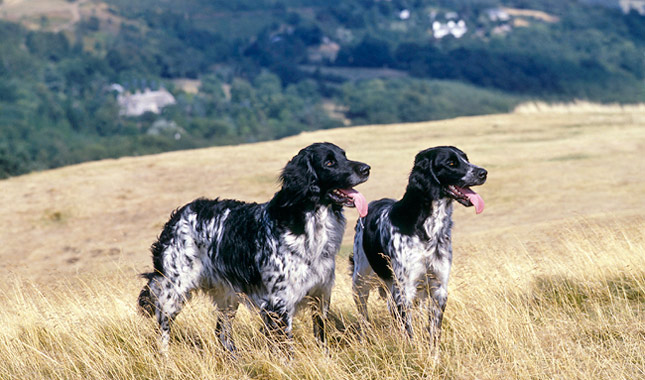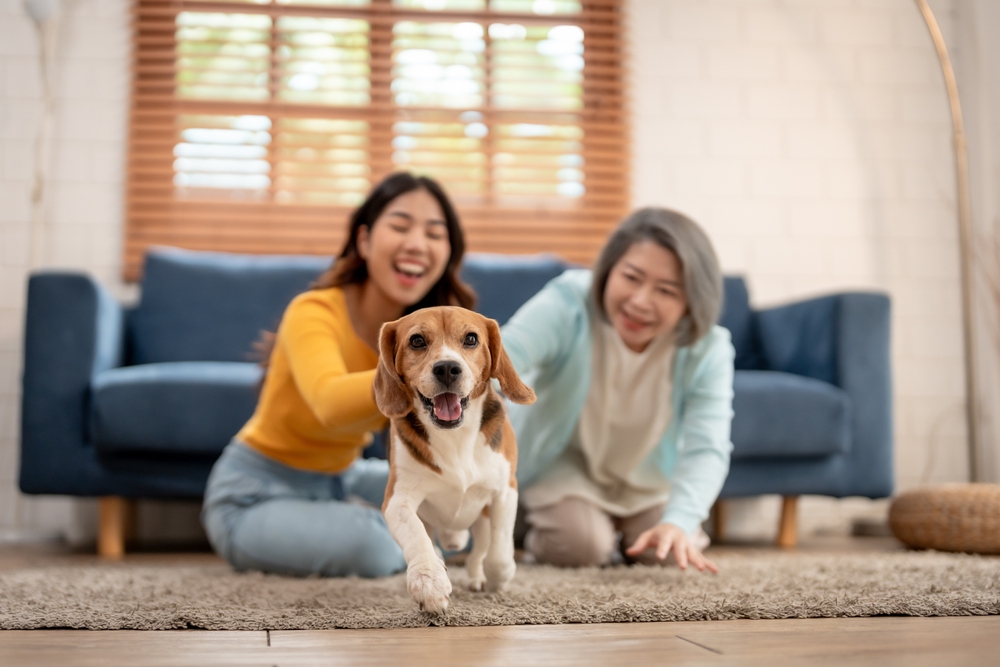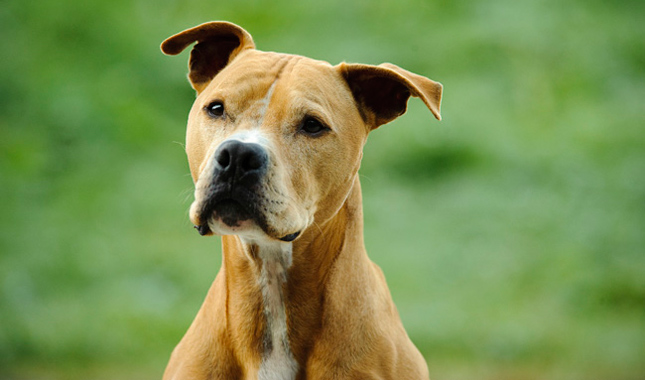Large Munsterlander
Published on July 04, 2011
Breed Details
- Height: 23 to 25 inches at the shoulder
- Weight: 50 to 75 pounds
Breed Characteristics
Adaptability
Trainability
Grooming
Apartament Friendly
Child Friendly
Shedding Level
Dog Friendly
Exercise Needs
Territorial
Barking Tendencies
Health Issues
Social Needs
Energy Level
Affectionate
Watchdog Instincts
Cat Friendly
Intelligence
Stranger Friendly
It would be a shame to get a Large Munsterlander if you don’t plan to hunt with him. It’s what he’s born to do, and his tracking, pointing and retrieving instincts are strong. In fact, most Large Munsterlander breeders will only place their pups in hunting homes. If you can meet his needs in this area and provide him with a large fenced yard and plenty of daily exercise, he can be a cheerful, gentle family companion. He’s highly trainable but needs gentle handling with positive reinforcement techniques.
Comb the coat frequently to prevent or remove mats and tangles. A bath every six weeks or is a good idea. In addition, trim the nails as needed, brush the teeth, and keep the ears clean and dry.
Last but not least, it should go without saying that a people-loving dog like the Large Munsterlander needs to live in the house. It’s an unhappy Large Munsterlander who is relegated to the backyard with little or no human companionship.
Other Quick Facts
- The Large Munsterlander is a versatile German sporting dog who hunts, points, and retrieves, working well on land and retrieving from water.
- At first glance, the Large Munsterlander resembles one of the Setter breeds, but he has a broader skull that is slightly rounded.
- The Large Munsterlander’s coat can be mostly white or mostly black, with markings that can be solid white patches or ticked or roan areas.
The History of the Large Munsterlander
A relatively new breed, the Large Munsterlander originated in the German town of Munster in the early 20th century. Based on depictions in artwork, dogs of similar type date to the Middle Ages, but the Large Munsterlander was not formally recognized as a breed until 1919. His ancestor was the German Longhaired Pointer, which was crossed with various Spaniels. The result was the Large Munsterlander, which, for a time, was a popular hunting dog throughout Europe. The combination of the Great Depression and World War II nearly caused the breed’s demise but it was revived after the war.
The first Large Munsterlanders to come to America arrived in 1966. In the United States, the breed’s development is overseen by the Large Munsterlander Club of North America. The United Kennel Club recognized the breed in 2006.
Large Munsterlander Temperament and Personality
Like all Sporting dogs, the Large Munsterlander is inclined to be smart, biddable, and should be a quick learner. He’s highly trainable — even at a young age — but his sensitive nature calls for a light touch. Typically, that is all that’s needed for this calm and gentle dog. He has a good nose and will range pretty far out, but he’s not so independent that he won’t come when called. Hunters prize him for his versatility in the field (he’s great at everything from finding birds to tracking bigger game and he loves, loves, loves to retrieve). He also impresses with his cheerfulness as a family dog when the hunting day is done.
The Large Munsterlander may be calm and gentle, but he’s also lively and needs much more exercise than the average person is prepared to give. The Large Munsterlander Club of North America is serious about seeing that these dogs go to hunting homes and it is rare that one will be placed solely as a pet. If you are fortunate enough to acquire one, be prepared to spend your days hiking, running, bicycling, and taking him to a safely enclosed park where he can chase squirrels. Hip dysplasia and some other joint issues have been reported in the breed, though, so get the green light from your veterinarian before undertaking any strenuous exercise with this dog.
Start training your puppy the day you bring him home. Even at eight weeks old, he is capable of soaking up everything you can teach him. Don't wait until he is six months old to begin training, or you will have a more headstrong dog to deal with. If possible, get him into puppy kindergarten class by the time he is 10 to 12 weeks old, and socialize, socialize, socialize. However, be aware that many puppy training classes require certain vaccines (like kennel cough) to be up to date, and many veterinarians recommend limited exposure to other dogs and public places until puppy vaccines (including rabies, distemper and parvovirus) have been completed. In lieu of formal training, you can begin training your puppy at home and socializing him among family and friends until puppy vaccines are completed.
Talk to the breeder, describe exactly what you’re looking for in a dog, and ask for assistance in selecting a puppy. Breeders see the puppies daily and can make uncannily accurate recommendations once they know about your lifestyle and personality. Whatever you want from a Large Munsterlander, look for one whose parents have nice personalities and who has been well socialized from early puppyhood.
What You Need To Know About Large Munsterlander Health
All dogs have the potential to develop genetic health problems, just as all people have the potential to inherit disease. Run from any breeder who does not offer a health guarantee on puppies, who tells you that the breed has no known problems, or who keeps puppies isolated from the main part of the household for health reasons. A reputable breeder will be honest and open about health problems in the breed and the incidence with which they occur.
Large Munsterlanders are generally healthy. Conditions reported in the breed include cataracts, hip dysplasia, and osteochondrosis. The Large Munsterlander Club of North America certifies breeders and puppies and approves all breedings. For puppies to receive full registration, both parents must have been certified free of hip dysplasia. In addition, both parents must have qualified in a field test of natural hunting ability, must meet the breed standard, and must have normal temperament.
Careful breeders screen their breeding dogs for genetic disease and breed only the healthiest and best-looking specimens, but sometimes Mother Nature has other ideas. A puppy may develop one of these diseases despite good breeding practices. Advances in veterinary medicine mean that in most cases the dogs can still live a good life. If you’re getting a puppy, ask the breeder about the ages of the dogs in her lines and what are the most common causes of death.
Remember that after you’ve taken a new puppy into your home, you have the power to protect him from one of the most common health problems: obesity. Keeping a Large Munsterlander at an appropriate weight is one of the easiest ways to extend his life. Make the most of diet and exercise to help ensure a healthier dog for life.
The Basics of Large Munsterlander Grooming
The Large Munsterlander has a medium-long silky coat with feathering on the ears, chest, belly, legs, and tail. Plan on combing it out every time the dog has been in the field. The breed sheds moderately. Brush him two or three times a week to keep dead hair from settling on your floor, furniture, and clothing.
The rest is basic care. Trim the nails as needed, usually every week or two. Keep the ears clean and dry, and brush the teeth frequently with a vet-approved pet toothpaste for good overall health and fresh breath.
Choosing a Large Munsterlander Breeder
Put at least as much effort into researching your puppy as you would into choosing a new car or expensive appliance. It will save you money in the long run. Whether you want to go with a breeder or get your dog from a shelter or rescue, here are some things to keep in mind.
Finding a quality breeder is a great way to find the right puppy. A good breeder will match you with the right puppy, and will have done all the health certifications necessary to screen out as many problems as possible. He or she is more interested in placing pups in the right homes than making big bucks.
Look for more information about the Large Munsterlander and start your search for a good breeder on the website of the Large Munsterlander Club of North America.
Reputable breeders will welcome your questions about temperament, health clearances, and what the dogs are like to live with. They will come right back at you with questions of their own about what you’re looking for in a dog and what kind of life you plan to provide. A good breeder can tell you about the history of the breed, explain why one puppy is considered pet quality while another is not, and discuss what health problems affect the breed and the steps were taken to avoid them. A breeder should want to be a resource for you throughout your dog’s life.
Avoid breeders who only seem interested in how quickly they can unload a puppy on you and whether your credit card will clear. Breeders who offer puppies at one price “with papers” and at a lower price “without papers” are unethical. You should also remember that buying a puppy from an “instant pet” website leaves you no recourse if what you get isn't exactly what you expected.
Lots of reputable breeders have websites, so how can you tell who’s good and who’s not? Red flags include over availability, multiple litters on the premises, a choice of any puppy, and the ability to pay online with a credit card. Those things are convenient, but they are almost never associated with reputable breeders.
And before you decide to buy a puppy, consider whether an adult Large Munsterlander might better suit your needs and lifestyle. Puppies are loads of fun, but they require a lot of time and effort. An adult Large Munsterlander may already have some training and will probably be less active, destructive, and demanding than a puppy. With an adult dog, you know more about what you’re getting in terms of personality and health. If you are interested in acquiring an older dog instead of a puppy, ask breeders about purchasing a retired show dog or if they know of an adult dog who needs a new home.
Adopting a Dog From a Large Munsterlander Rescue or Shelter
The Large Munsterlander is a rare breed with a very involved breed club. Finding one through a breed-rescue group or in an animal shelter is highly unlikely. Nonetheless, the Large Munsterlander Club of North America keeps a waiting list of people who are interested in case one does need a home.
If you live in an area where hunting is a common activity, don’t overlook your local animal shelter. It’s unlikely but not impossible for a Large Munsterlander to be found in a shelter after losing his home to an owner’s death, in a divorce, or a changed economic situation.
Here are other ways to find a Large Munsterlander to adopt.
1. Use the Web
Sites like Petfinder.com and Adopt-a-Pet.com can have you searching for a Large Munsterlander in your area in no time flat. The site allows you to be very specific in your requests (housetraining status, for example) or very general (all the Large Munsterlanders available across the country). AnimalShelter can help you find animal rescue groups in your area. Also some local newspapers have “pets looking for homes” sections you can review.
Social media is another great way to find a dog. Post on your Facebook page that you are looking for a specific breed so that your entire community can be your eyes and ears.
2. Reach Out to Local Experts
Start talking with all the pet pros in your area about your desire for a Large Munsterlander. That includes vets, dog walkers, and groomers. When someone has to make the tough decision to give up a dog, that person will often ask her own trusted network for recommendations.
3. Talk to Breed Rescue
Most people who love Large Munsterlanders love all Large Munsterlanders. That’s why breed clubs have rescue organizations devoted to taking care of homeless dogs. Search online for Large Munsterlander rescues in your area.
The great thing about breed rescue groups is that they tend to be very upfront about any health conditions the dogs may have and are a valuable resource for advice. They also often offer fostering opportunities so, with training, you could bring a Large Munsterlander home for a trial to see what the experience is like.
4. Key Questions to Ask
You now know the things to discuss with a breeder, but there are also questions you should discuss with shelter or rescue group staff or volunteers before you bring home a pup. These include:
- What is his energy level?
- How is he around other animals?
- How does he respond to shelter workers, visitors, and children?
- What is his personality like?
- What is his age?
- Is he housetrained?
- Has he ever bitten or hurt anyone that they know of?
- Are there any known health issues?
Wherever you acquire your Large Munsterlander, make sure you have a good contract with the seller, shelter, or rescue group that spells out responsibilities on both sides. Petfinder offers an Adopters Bill of Rights that helps you understand what you can consider normal and appropriate when you get a dog from a shelter. In states with “puppy lemon laws,” be sure you and the person you get the dog from both understand your rights and recourses.
Puppy or adult, a breeder purchase or a rescue, take your Large Munsterlander to your veterinarian soon after adoption. Your veterinarian will be able to spot problems and will work with you to set up a preventive regimen that will help you avoid many health issues.











